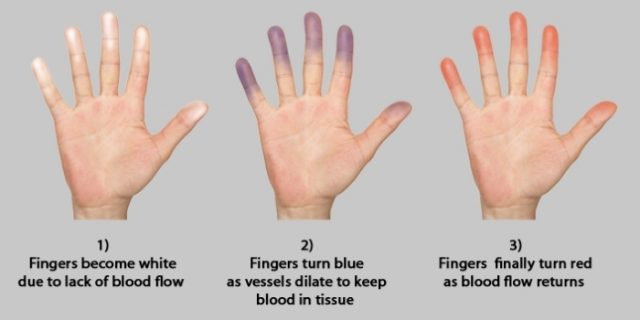Understand the symptoms and triggers of Raynaud’s Disease and how to prevent them.
Raynaud’s Disease (or phenomenon) occurs with an exaggerated response in the body that causes a constriction of the blood vessels. In this case, the mechanisms that control the constriction of the blood vessels are altered or defective.
Most commonly occurring in fingers and toes, Raynaud’s disease symptoms is evidenced by a change in skin color in response to cold weather or emotional stress. This disease is more common in women than men.

In an occurrence of Raynaud’s, there are three phases represented by changes in skin color.
Phase 1
Severe constriction of the blood vessels in the affected area makes the skin surface cold to touch and white in color. There is virtually no blood flow to the affected area.
Phase 2
When the reduced flow of blood to the skin slowly returns, the skin typically turns a purple-blue color.
Phase 3
When the affected blood vessels become completely dilated allowing blood flow to resume, the skin turns red.
Besides color changes, symptoms that can be experienced during an attack include a feeling of “pins and needles”, aching, numbness, or clumsiness in the affected hand(s).
Raynaud’s disease can occur alone without a related disease. Also, it may be a family trait or occur as a secondary condition to an underlying condition such as Autoimmune Rheumatic Disease (a group of conditions that affect the joints, bones, muscle, and connective tissues).
What are the triggers and ways to prevent or avoid triggers?

- Stay warm and bundle up. Since cold exposure can trigger an attack, find ways to keep the entire body warm, such as dressing in layers and wearing mittens, socks, tights and a hat. Avoid rapidly shifting temperatures and cold breezes.
- Avoid smoking. The nicotine in cigarettes causes constriction of the blood vessels. Smoking can cause and aggravate Raynaud’s disease.
- Consult with your doctor to avoid medications that cause blood vessels to constrict. These medications include decongestants, such as Phenylephrine, Ephedrine and Pseudo Ephedrine. They also include migraine medications, such as Ergotamine, and medications used to treat ADD, such as Amphetamine.
- At the first sign of an attack, immerse your hands and/or feet in warm water. If warm water is not easily accessible, cross your arms and place your hands in your armpits.
- Stress can also trigger Raynaud’s disease. Actively manage your stress and consider using relaxation techniques that can quickly ease stress.
- Vibrations from hand mixers and power tools can trigger a flare-up. Avoid using these tools.
- Protect your hands to avoid a trigger when removing items from the freezer.
What medications are used to treat existing Raynaud’s disease?
Medications are generally recommended if the prevention measures mentioned above do not reduce the frequency and severity of attacks. The medications used include Calcium Channel Blockers, Nitrates, and Sildenafil (Viagra).


